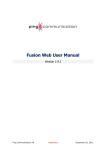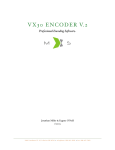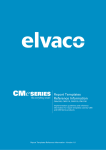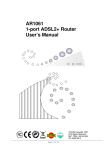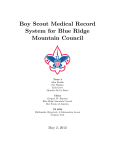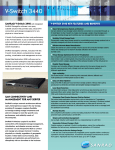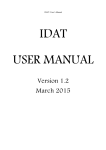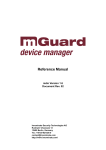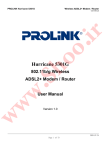Download Fusion Installation
Transcript
Fusion FreeACS Installation
Version 2014R1
Table of Contents
Table of Contents
................................................................................................................................................. 1
Fusion FreeACS Installation ...................................................................................................... 1
Document Introduction .............................................................................................................. 3
Name of the system ................................................................................................................ 3
Document Purpose ................................................................................................................. 3
Document Audience ............................................................................................................... 3
Document History .................................................................................................................. 3
Quick Overview ......................................................................................................................... 4
Infrastructure: ......................................................................................................................... 4
Modules .................................................................................................................................. 4
Customer requirements .............................................................................................................. 5
Hardware ................................................................................................................................ 5
OS ........................................................................................................................................... 6
Database ................................................................................................................................. 6
Java and Web container .......................................................................................................... 6
Installation from scratch ............................................................................................................. 8
/etc/mysql/my.cnf ................................................................................................................... 8
/var/lib/tomcat7/conf/catalina.properties................................................................................ 8
/etc/default/tomcat7 ................................................................................................................ 9
/etc/passwd ............................................................................................................................. 9
/var/lib/tomcat7/conf/server.xml ............................................................................................ 9
/etc/init.d/tomcat7 ................................................................................................................... 9
/var/lib/tomcat7/common/xaps-monitor.properties ................................................................ 9
/var/lib/tomcat7/common/xaps-stun.properties .................................................................... 10
/var/lib/tomcat7/common/xaps-web.properties .................................................................... 10
Restart, firewalls and checks ................................................................................................ 10
Optional steps – Tomcat on HTTPS (SSL) .......................................................................... 10
Technical reference and documentation ................................................................................... 13
Property files ........................................................................................................................ 13
Log files................................................................................................................................ 13
Fusion logs ....................................................................................................................... 13
Firewalls ............................................................................................................................... 13
Documentation ..................................................................................................................... 14
1 Document Introduction
1.1 Name of the system
The current name of the system is “Fusion FreeACS”. As this is a relatively new name, the
old name “Fusion” is in frequent use and may continue to be for a very long time. An even
older name “xAPS” is also in use.
1.2 Document Purpose
The purpose of the document is to explain how to install Fusion FreeACS (chapter 4).
1.3 Document Audience
The readers will be Fusion Administrators and System Operators.
1.4 Document History
Version
2009-R1
Editor
Morten Simonsen
Date
18-Feb-09
Changes
Initial public version.
2009-R1-U1
Fredrik Gratte
31-Mar-09
Updated platform requirements.
2009-R2
Morten Simonsen
02-Jul-09
Revised edition
2011R1
Morten Simonsen
21-Jan-11
Revised edition
2012R1
Morten Simonsen
28-Dec-11
Name change/upgrade from
2011R1 procedure. Added a
chapter.
2013R1
Morten Simonsen
17-Jan-13
Updated to latest release
2014R1
Morten Simonsen
03-Feb-14
System is no longer a commercial
product – is licensed under the MIT
license for free usage. The
differences between 2013R1 and
2014R1 are otherwise small.
2014R1
Morten Simonsen
07-Jul-14
Major overhaul. Has created an
install-script to do most of the work
automatically. Updated to run on
Ubuntu 14.04. The installation
procedure has been brought down
to minimum 5-6 minutes.
3
2 Quick Overview
A complete installation of a Default Setup is provided in chapter 4, you may skip chapter
2 and 3.
Fusion can be run in several configurations depending on your needs. The following section
will list all modules and comment on where there is a choice to be made.
2.1 Infrastructure:
This list can also be read as requirements from Ping Communication to the customer, as the
customer needs to be knowledgeable about these infrastructure parts, or at the very least be
able to acquire the necessary knowledge, to maintain all these components.
Fusion can run on one physical server if necessary. Several factors come into play to
decide how many servers is optimal.
Operating system which can run JRE 1.7 (see details and exception to this below in
the 'OS' chapter).
MySQL 5.5
JRE 1.7 (latest update).
Tomcat 7 (other web containers are possible, but not described)
2.2 Modules
North-side modules (user interface modules):
Fusion Web (Standard web interface for management)
Fusion Shell (CLI, script automation, management)
Fusion Web Services (if system integration is needed)
Core modules:
Fusion DB (table definitions)
Fusion Core
Fusion Syslog Server
Fusion Monitor Server
South-side modules (CPE interface modules):
Fusion TR-069 Server (if you have TR-069 devices)
Fusion STUN (needed to support TR-111)
Fusion SPP (needed to provision HTTP/TFTP/Telnet)
The following chapters will explain how to install these modules.
4
3 Customer requirements
3.1 Hardware
There are many ways one could organize the hardware to satisfy Fusion. You could do with
one physical server at start up. As the number of devices connected to Fusion grows, you
should probably split the processes/modules on several servers. This table should give you a
quick overview of how Ping Communication thinks about this issue:
Devices w/syslog
Fusion Web available
on internet
Servers required
Connects pr 24h
CPEs
50K
500K
1
1
Y
N
Y
N
1
2
500K
1
Y
N
3
500K
24
N
N
5
12M
1
Y
Y
7
Comments
The minimum requirement, see below for spec. for server.
You should have server with the provisioning server (TR069 or OPP) in DMZ and the rest of the modules on
another server within your intranet. This requirement is
mainly due to security reasons.
Same as for the above, but syslog could generate a huge
load, so it could be smart to have a separate server for the
Fusion Syslog Server & Fusion Syslog DB.
You should have 3 provisioning servers, since the CPEs
connect 24 times a day. The database would be put under
some load here, so the database should also be place on its
own server. The rest of the modules could be placed on one
server.
The same load as in the previous example, but syslog is
turned on, so it will require a database server extra. And
don’t put Fusion Web on one of the provisioning server,
just because they are both located in the DMZ, use a
separate server for that module.
A server is expected to have a decent multi-core processor, minimum 8GB RAM, minimum
100 Mbit network interface and hard disk capacity of at least 500GB (this last requirement is
only important for the database server). We expect the usage of fast HDD, since this is critical
for the database. The minimum specification translates to some of the test servers we have
used. Looking closely at these figures you should realize that this specification is a low-end
system these days. A state-of-the-art system today (jan 2013) would probably have more
capacity. So if you think the number of servers will grow too rapidly with increasing numbers
of connects pr 24h, keep in mind that in that situation you would probably use a state-of-theart system, minimizing the number of servers required.
The tests we have done to come up with this list will of course not represent the absolute truth
about how a potential customer will use the system. Particularly the number of parameters in
5
the database, jobs activated, logging scheme, number of end users, number of interconnecting
systems, will influence the performance. That said, we think these figures give a reasonable
and reliable picture of the situation.
If you decide to run on multiple servers, the first split should be between Fusion DB and the
provisioning servers (SPP or TR-69), since these components are affected the most by an
increase in devices. Another important point is that you can add provisioning servers to scale
up the system, all of them connecting to the same Fusion DB Server. There is another reason
for this split as well, and that is that the provisioning servers must be reachable for all the
devices, a requirement which you might not want for your database!
Another split would be to put all the interface modules (Fusion Web, Fusion Shell and Fusion
Web Services) on a separate server. A trigger for this move would be to secure these interfaces
from direct access from the Internet.
Yet another split would be to put a syslog server and the syslog database on its own server, but
that is something one does only if there’s a significant load on the syslog server.
The bottleneck of this system will eventually be the database. However we believe that this
bottleneck will not be hit before at least 10M CPEs are connected, possibly not before 3050M CPEs are connected (it all depends on many factors). But this does not take into account
that the database server may run in a cluster. We have not experimented with this, but we still
believe this is an option, an option that no customer today is likely to reach without a very
aggressive provisioning policy (e.g. many connects pr CPE every 24h).
3.2 OS
All modules in Fusion are Java applications. In theory they can be installed on any OS that
supports JRE 1.7 and has an available web-container (like Tomcat 7). We have chosen to run
on Linux, Ubuntu Server 14.04, 64 bit, and we suggest that our customers do the same. If they
do, it's easy to follow the installation procedure in chapter 5.
3.3 Database
Currently Fusion will only run on MySQL 5.5.
How to install MySQL is considered the responsibility of the customer. Furthermore it may be
necessary to tweak the database somewhat as the load grows. This competence should be
found within your company. That is to say that Fusion is not a fool-proof system and will
require some technical people to take part in the installation and operation.
That said we do have an installation procedure for a complete set up of a standard Fusion
Server which includes a reasonably good set up of MySQL 5.5. This was done to minimize
our own support effort in the installation process, but also serves us well because the
installation of Fusion becomes more coherent across customers. Chapter 5 contains the
detailed installation procedure of such a standard set up.
3.4 Java and Web container
As for the databases, you need to be able to install Java and a web container on your system.
Fusion requires JRE 1.7, preferably the latest update. When this is installed you can install the
6
web container. Tomcat 7 has been used in development but other web containers can also be
used, since they offer the same runtime environment for Fusion applications.
7
4 Installation from scratch
You can have Fusion FreeACS up and running in 30 minutes, or possibly even in just 5
minutes (if you do this for the second time). Just read on.
The goal is to install a standard Fusion Server (Default Setup), which requires installation of
Ubuntu Server 14.04 64-bit, MySQL Server 5.6 (latest update), Tomcat 7 and JRE 1.7 (latest
update). How to install Ubuntu 14.04 64-bit is beyond the scope of this simple document, but
otherwise all other software installation is described. This is not to say that one cannot run on
any other OS or J2EE server, but this is the standard/default Fusion installation recommended
for most users.
Do the following:
1. Download install-or-update-freeacs-ubuntu.sh from http://freeacs.com/download
and run the script from your home folder on your ubuntu server. You must have
root access. This covers 90% of the installation, and can be done in 1-5 minutes.
2. Go through the rest of the modifications described in this chapter. Should be
possible to do in 5-30 minutes.
3. The server should be ready
Important!! Yellow color indicates an optional step, but it's wise to read the comments before
skipping.
4.1 /etc/mysql/my.cnf
Step Command/Text
4.1.1 bind-address = 0.0.0.0
4.1.2 max_allowed_packet = 32M
4.1.3 innodb_buffer_pool_size=1024M
4.1.4 service mysql restart
Comment
If you want your database to be accessible
from outside localhost, set to 0.0.0.0. Else, the
database will only be accessible for
applications running on localhost (like Fusion
server).
Should be at least 32M, to allow adding
firmwares up until this size into the Fusion
database
This is the most important memory setting,
MySQL should have access to perhaps 50% av
of total memory on server. If you set this
setting to high MySQLs InnoDB engine may
silently fail! Check in 2.7.
Restart MySQL after changes
4.2 /var/lib/tomcat7/conf/catalina.properties
Step
4.2.1
Command/Text
Append the following:
,${catalina.base}/common,${catalina.bas
8
Comment
Edit the configuration file of tomcat to
point to a directory where Fusion
properties will be placed. There should
e}/common/*.properties
not be any line breaks or spaces in the
appended text!
to the property “common.loader”
4.3 /etc/default/tomcat7
Step Command/Text
4.3.1 AUTHBIND=yes
Comment
Optional! AUTHBIND=yes will make it
possible for Tomcat to run on lower ports
(80 and 443). Take care to remove the #
comment at the beginning of the line.
4.3.2 JAVA_OPTS="-Djava.awt.headless=true - JAVA_OPTS is only changed slightly, to
Xmx768m increase maximum memory usage from
XX:+UseConcMarkSweepGC"
128 megabyte till 768 megabyte. This
should be sufficient for 10-50K devices.
4.4 /etc/passwd
Step Command/Text
4.4.1 Change “/usr/share/tomcat7” to “/var/lib/tomcat7”
Comment
This changes Tomcat's home
directory from
/usr/share/tomcat7 to
/var/lib/tomcat7.
4.5 /var/lib/tomcat7/conf/server.xml
Step Command/Text
4.5.1 <Connector port="80"
protocol="HTTP/1.1" ….
Comment
Default setup of Tomcat is port
8080, we'll change it to 80 (default
HTTP port).
4.6 /var/lib/tomcat7/conf/context.xml
Step Command/Text
4.6.1 <Context …..
sessionCookiePath=”/” ….>
Comment
Some CPEs struggle to set the JSESSIONID
HTTP cookie issued by the server. Without this
cookie, nothing will work! This configuration
change *MAY* help – it has helped some at
least. I am not sure if this can hurt in some
cases (why it is not default in Tomcat7?).
Some CPEs have struggled with this particular
useHttpOnly directive (set in the HTTP
header), and as a an end result, failed to set the
JSESSIONID cookie required by the server
(same as the situation above). This
configuration *MAY* help – it has helped
some at least. I am not sure if this can hurt in
some cases (why it is not default in Tomcat7?).
4.6.2 <Context …..
useHttpOnly=”false” … >
9
4.7 /etc/init.d/tomcat7
Step Command/Text
Comment
4.7.1 Find the line beginning with “# Required-Start:” Some Fusion services have a habit
and append “$mysql” to it.
of reporting e-mail errors if they
cannot connect to the database
when they start. (E.g. when
rebooting the machine) To avoid
this, we make Tomcat depend on
MySQL for it to start on boot.
4.8 /var/lib/tomcat7/common/xaps-monitor.properties
The monitor server itself is not critical for FreeACS, it's main job is to send email and monitor
the other servers in the FreeACS solution.
Step Property
Comment
4.8.1 mail-settings
Specify in order to get mail about events and errors in FreeACS
4.8.2 fusion.urlbase
This url will be used in mail sent to you; specify a url-base
which can reach the FreeACS from “outside”
4.9 /var/lib/tomcat7/common/xaps-stun.properties
The STUN server is fairly important, since all server-side triggering of provisioning goes
through this server. Thus, if you try to «kick» the CPE or press the «provisioning» button in
the Web interface, the STUN server must have a correct configuration.
Step Property
Comment
4.9.1 primary.ip
Set it to the IP address of your server. The server will try to bind
to this IP on port 3478. If this fails, the server will not start
unless you change the test.runwithstun
4.9.2 test.runwithstun
The server will start even if the STUN behaviour is not
supported. In this case, the server can still be used to trigger/kick
CPEs available on public ConnectionRequestURL addresses.
4.10 /var/lib/tomcat7/common/xaps-web.properties
Step
Property
4.10.1 monitor.location
Comment
It should return a web-page (use wget to test). If not, change the
url or check if the Monitor server is actually running.
4.11 Restart, firewalls and checks
Step
4.11.1
Command/Text
service tomcat7 restart
4.11.2
wget localhost
wget localhost/web
wget localhost/tr069
Comment
Check /var/lib/tomcat7/logs/catalina.out to make sure
Tomcat7 starts without errors.
If you have a firewall, open for TCP/80. You can check to
see if tomcat is available by using the command. If
everything went well you should get the FreeACS Web
interface, with an user/password prompt. Login using
admin/xaps as user/pass. You may of course change the
default password inside the web application.
If the FreeACS Web interface does not appear, then try
http://localhost/web. The TR-069 server should be
10
Step
Command/Text
4.11.3
fusionshell
4.11.4
See chapter 5.3
4.11.5
COMPLETE
Comment
available on http://localhost/tr069. The TR-069 clients
will connect using HTTP POST, while the “browser”
returns the response from HTTP GET.
You should log out of Ubuntu and log in again, before
attempting this command, unless you might get some
error messages. This shell is crucial is providing a
scripting environment to FreeACS.
Several port openings may be expected if a firewall is
present
The server is now ready!
4.12 Optional steps – Tomcat on HTTPS (SSL)
At this point in the installation, all FreeACS servers run on the same Tomcat instance. Let's
say you want to have a secure communication with your CPE (most people do), you would
then need to create a SSL server-side certificate and all your CPEs would have to accept this
certificate. This certificate would be shared by all servers running in the same Tomcat
instance. The consequence is that if you, for some reasons want to have a different certificate
for you FreeACS Web interface – that server would have to run on another Tomcat instance,
most likely on another host. The same goes for the TR-069 server, if you want to support
various CPEs which demands a particular SSL certificate, you need to create several TR-069
servers, each with it's own certificate installed.
If you run Fusion TR-069 server AND you want to provision Ping Communication devices
using TR-069, please follow step 7.1-alt1.
If you do not provision Ping Communication devices, but still wish to avoid warnings when
you use Fusion Web, please follow step 7.1-alt2
Otherwise follow step 4.12.1-alt3 or 4.12.1-alt4.
Step
4.12.1-alt1-1
Command
4.12.1-alt1-2
4.12.1-alt1-3
4.12.1-alt1-4
unzip build_jks.zip
chmod 755 *.sh
./build_jks_class1.sh
Comment
Buy (class2) or get for free (class1) a
certificate from StartSSL
(http://www.startssl.com/).
4.12.1-alt2
4.12.1-alt3
keytool -genkey -alias xaps
-keyalg RSA -validity
10000 -keystore
/var/lib/tomcat7/.keystore
11
Make the scripts runnable
The command will show you help text and
how to run the script. If you bought class2
certificates, run the other script.
Buy your own certificate and import it into a
java keystore (using keytool -import). You
may of course use the suggested certificate
from StartSLL (5.1-alt1-1)
Follow the steps show in screenshot 7.1. The
information you enter into the certificate will
only be shown when you examine the
certificate in a browser. The certificate should
4.12.1-alt4
5.2
5.3
5.4
keytool -list -keystore
/var/lib/tomcat7/.keystore storepass importkey
pico
/var/lib/tomcat7/conf/server
.xml
service tomcat7 restart
5.5
Screenshot 7.1
12
be valid for 10000 days. Note that browsers
do not like this self-signed certificate, if you
want a real certificate, you must purchase one.
Copy keystore from old server/installation
into you're working folder. In that case, you
should also use the same keystore-password
and alias as you had in the old server.xml.
List the key aliases, you will need it in the
next step.
Edit the file to match screenshot 7.2, using the
alias acquired in the previous step. This
change will still allow traffic on HTTP, to
avoid that uncomment the connector for port
8080 (or 80)
Start a browser and locate the Fusion Web
interface. Usually https://localhost
If you have a firewall, open for TCP/443
Screenshot 7.2
13
5 Technical reference and documentation
In this chapter you'll find important information of a installed Fusion system; where to find
log files, firewall settings, etc. By following the instructions in chapter 4, you'll end up with a
Default Setup (DS), and for this setup we'll provide exact information.
5.1 Property files
Property files are found in /var/lib/tomcat7/common and also in /var/lib/tomcat7/shell.
Each module has two property files following these conventions:
xaps-<modulename>.properties: Contains all properties and control mechanism for the
module.
xaps-<modulename>-logs.properties: Contains all properties to control logging, number of
logs, name of logs, loglevels, backups, etc.
Information about the various property files are found in the User Manuals of each module,
but each property file is supposed to be self-documented.
5.2 Log files
Fusion logs
Log files are found in /var/lib/tomcat7. The logs are named following this convention:
fusion-<modulename>(-<optionalname>).log. Usually every module has a default/regular
log: fusion-<modulename>.log, but some modules have multiple logs. Each log file can be
controlled by settings in the corresponding xaps-<modulename>-logs.properties files (see
previous chapter).
Old logs can be found in the backup-logs directory. These logs are kept for as long as
specified in the logs-properties file.
5.3 Firewalls
The following holes in the firewall may/must be opened (for those modules placed behind the
firewall):
Module
Port
Type
Comment
Monitor, TR069,
SPP, Web, WS
80
TCP
In case you have setup the installation to run on
port 80 (see chapter 4.5) To allow requests into
TR-069 or HTTP for provisioning. Also access
to monitor-server, Web and Web Services.
Monitor, TR069,
SPP, Web, WS
8080
TCP
In case you run DS (skipped chapter 4.5). To
allow requests into TR-069 or HTTP for
provisioning. Also access to monitor-server,
Web and Web Services.
Monitor, TR069,
SPP, Web, WS
443
TCP
In case you have setup the installation to run on
port 443 (see chapter 4.8). To allow requests
into TR-069 or HTTP for provisioning. Also
access to monitor-server, Web and Web
14
Services.
SPP
69
TCP
To allow TFTP-provisioning (offered by the
SPP server)
DB
3306
TCP
Allows direct access to MySQL database (see
chapter 4.1). This allows Fusion Shell to run on
a remote host accessing the DB directly.
STUN
3479
UDP
To support TR-111 (the devices must also
support this) and devices access this STUNserver.
UDP
To allow syslog messages to be sent to Fusion
Syslog server. Should always be open.
3480
Syslog
9116
5.4 Documentation
All modules have a User Manual, to describe how to use the system. Some modules also have
additional documentation. These documents are found in GitHub on the following locations.:
Server
URL
Comment
General
https://github.com/freeacs/readme
General
documentation
Core
https://github.com/freeacs/core/tree/master/docs
Monitor
https://github.com/freeacs/monitor/tree/master/docs
Shell
https://github.com/freeacs/shell/tree/master/docs
SPP
https://github.com/freeacs/spp/tree/master/docs
STUN
https://github.com/freeacs/tr069/tree/master/docs
Syslog
https://github.com/freeacs/syslog/tree/master/docs
TR-069
https://github.com/freeacs/tr069/tree/master/docs
Web
https://github.com/freeacs/web/tree/master/docs
Web
Services
https://github.com/freeacs/ws/tree/master/docs
15
Chapter 7















